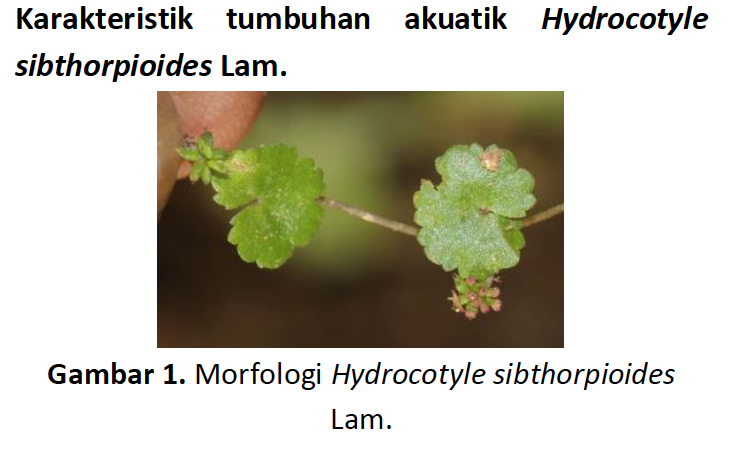Potential of the Aquatic Plant Hydrocotyle Sibthorpioides Lam as an Antidiabetic Substance for Type 2 Diabetes Mellitus (T2D)
DOI:
https://doi.org/10.36733/usadha.v4i1.10459Keywords:
Hydrocotyle Sibthorpioides Lam, Antidiabetic, Type 2 Diabetes MellitusAbstract
Type 2 diabetes mellitus is a condition of hyperglycemia caused by the insensitivity of cells to insulin even though insulin levels in the body are within the normal range. Hydrocotyle sibthorpioides Lam contains several important compounds, such as triterpenoid saponins, genin triterpenoids, essential oils, phytosterols, and flavonoids. This flavonoid compound is one of the potentially dominant compounds for people with type 2 diabetes mellitus. The purpose of writing this article is to determine the potential of the aquatic plant Hydrocotyle sibthorpioides Lam as an antidiabetic substance for type 2 diabetes mellitus (T2D). The research method used is a literature review with the number of articles used more than 10 journal articles. Flavonoids contained in the aquatic plant extract of Hydrocotyle sibthorpioides Lam have the potential as an antidiabetic drug by increasing insulin sensitivity in diabetics through its role in regulating insulin signaling mechanisms in target organs. Extracts from Hydrocotyle sibthorpioides Lam have great potential to be developed as an alternative treatment for type 2 diabetes mellitus (T2D). Further research and testing is needed regarding the effectiveness and side effects of this plant extract as a diabetes therapy.
References
E. Erlidawati, S. Safrida, and M. Mukhlis, “Potensi Antioksidan Sebagai Antidiabetes,” Potensi Antioksidan Sebagai Antidiabetes, pp. 1–11, 2018, doi: 10.52574/syiahkualauniversitypress.350.
N. Restyana, “Restyana Noor F|Diabetes Melitus Tipe 2 DIABETES MELITUS TIPE 2,” J Major. |, vol. 4, 2015.
A. Swargiary and M. Daimari, “GC–MS analysis of phytocompounds and antihyperglycemic property of Hydrocotyle sibthorpioides Lam.,” SN Appl. Sci., vol. 3, no. 1, pp. 1–11, 2021, doi: 10.1007/s42452-020-04101-2.
R. Yan, L. Gu, L. Qu, X. Wang, and G. Hu, “New Insights into Phylogenetic Relationship of Hydrocotyle (Araliaceae) Based on Plastid Genomes,” Int. J. Mol. Sci., vol. 24, no. 23, 2023, doi: 10.3390/ijms242316629.
A. V Gilman, E. T. Doucette, B. Engstrom, A. Marcus, and M. J. Peters, “Additions to the New Flora of Vermont–II,” Phytoneuron, vol. 16, pp. 1–17, 2020.
J. Barukial and J. N. Sarmah, “Ethnomedicinal plants used by the people of Golaghat District , Assam , India,” Int. J. Med. Arom. Plants, vol. 1, no. 3, 2011.
S. Gusriyani, Y. Aldi, S. Umar, and A. Afriwardi, “Literature Review: Effect of Pegagan Embun (Hydrocotyle sibthorpioides Lam.) Extract on NK and CD8 Cell Activity,” JPK J. Prot. Kesehat., vol. 12, no. 2, pp. 91–96, 2023.
S. P. Manavi, T. Amiri, and M. J. Mozafaryan, “Role of Flavonoids in Diabetes,” J. Rev. Med. Sci., vol. 1, no. 3, 2021.
A. Anggraini, “Manfaat Antioksidan Daun Salam Terhadap Kadar Glukosa Darah Dan Penurunan Apoptosis Neuron Di Hippocampus Otak Tikus Yang Mengalami Diabetes,” J. Med. Hutama, vol. 2, no. 01, 2020.
GBIF, “Hydrocotyle sibthorpioides Lam.,” Global Biodiversity Information Facility. Accessed: Nov. 29, 2024. [Online]. Available: https://www.gbif.org/species/8418338
I. Hazarika, G. K. Mukundan, P. S. Sundari, and D. Laloo, “Journey of Hydrocotyle sibthorpioides Lam.: From traditional utilization to modern therapeutics—A review,” Phytotherapy Research, vol. 35, no. 4. 2021. doi: 10.1002/ptr.6924.
A. Afriwardi, F. Wahyuni, E. Husni, A. A. Alianta, and Y. Aldi, “Effect of Standardised Extract Pegagan Embun (Hydrocotyle sibthorpioides Lam.) toward Natural Killer Cell and CD8 Cell Activities on White Male Mice Exposed to H5N1 Virus Antigen,” Open Access Maced. J. Med. Sci., vol. 10, 2022, doi: 10.3889/oamjms.2022.8667.

Downloads
Published
Issue
Section
License
Copyright (c) 2025 Usadha

This work is licensed under a Creative Commons Attribution-NonCommercial 4.0 International License.




